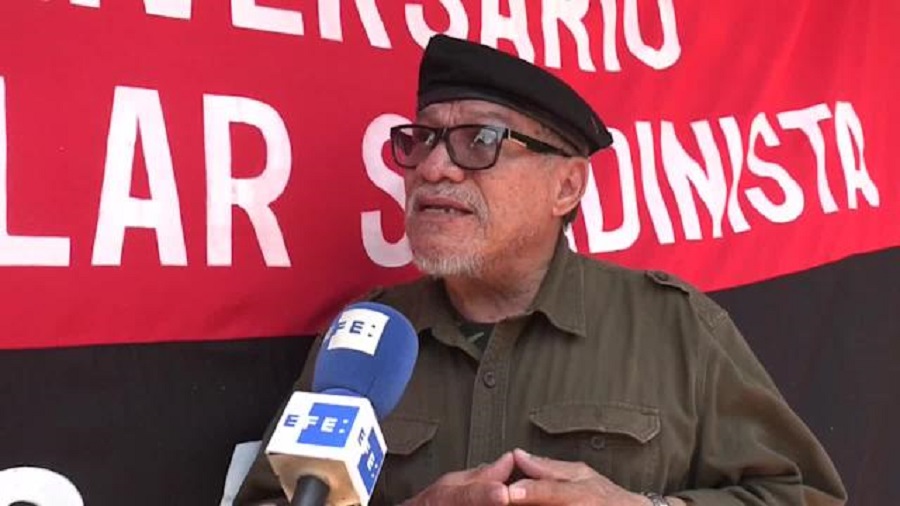RIO DE JANEIRO, BRAZIL – Veteran Sandinista militant Donald Mendoza said that the United States considers the Sandinista National Liberation Front (FSLN), which on Friday celebrated its 60th anniversary, to be “a menace,” and “is the only alternative to lift the Central American country out of poverty,” he said.
Washington “always has us in its sights, it regards us as a threat,” said Mendoza, former Nicaraguan military attaché to the United States during the first Sandinista government (1979-1990).
“Nicaragua does not have nuclear weapons for them to perceive us as a menace, but that is how the United States sees us,” he added, albeit providing no evidence.

According to the retired Army major, known by the nickname “Comandante 31” and the alias “Cara de Piña”, “the problem is the flag raised by Daniel (Ortega) and the FSLN all its life, which is patriotism, non-alignment, and the United States doesn’t like that in its geopolitical positions.”
FSLN WAS BORN AFTER TRIP TO CUBA
During the 60th anniversary of the FSLN, Mendoza praised the country’s president, former guerrilla Daniel Ortega, who returned to power in 2007 and is described as an “indisputable leader, revolutionary, sensitive, humane,” and the Sandinistas for reaching their 60th anniversary.
“We are celebrating the 60th anniversary of the FSLN’s foundation by a group of revolutionary comrades of that time,” among whom he mentioned Colonel Santos López, a member of the Army for the Defense of National Sovereignty led by Augusto C. Sandino (1895-1934), a national hero who fought against the occupation of U.S. troops in Nicaragua between 1927 and 1934.
He explained that prior to the FSLN’s foundation, movements inspired by the 1959 Cuban revolution led by the late Fidel Castro were created.
“The concerns in Nicaragua to form a group to confront the Somoza dictatorship was something transcendental. That was an idea of Carlos Fonseca Amador (one of the FSLN founders), that’s why they travelled to Cuba and formed the link,” he said.
He recalled that in October 1963, during the first FSLN guerrilla action in Raití-Bocay, in the department of Jinotega (north), “virtually all guerrillas were annihilated,” and in 1967, in Pancasán, Matagalpa (north), the National Guard eliminated another guerrilla unit.
Later came “a process of silence between 1967 and 1974,” of “accumulation of forces and it exploded” on December 27, 1974 when a Sandinista commando raided José María Castillo’s home, one of president Anastasio Somoza Debayle’s ministers, who died on the night of the attack and which enabled the release of a group of political prisoners, among them Ortega, imprisoned for 7 years.
CLAIMS THAT FSLN RESTORED RIGHTS
From 1974 to 1979 the FSLN entered a stage of internal division and 3 groups were created, which ultimately succeeded in uniting 4 months before the overthrow of the dictatorship of Somoza Debayle and “18 years after the founding of the FSLN, the triumph longed for by the Nicaraguan people was achieved.”
The veteran militant said that during the first revolutionary stage (1979-1990), a mixed economy, agrarian reform and a literacy campaign were put into practice.
“The revolution was upheld because an armed attack was launched and we entered a period of all-out war promoted by U.S. President Ronald Reagan, which practically destroyed the country’s economy,” he added.
In 1990 the FSLN lost power at the polls when Ortega was defeated by Violeta Barrios de Chamorro, and “16 difficult years” began for the opposition, said Mendoza, who on August 20, 1993 led the “Command for the Dignity of National Sovereignty,” kidnapping some 20 leaders of the now defunct National Opposition Union (UNO), among them the then Vice President of Nicaragua Virgilio Godoy.
After the return of the Sandinistas to power in 2007, the FSLN’s model is to work for the restitution of Nicaraguans’ social rights, he said.

